Each month, Reuters selects about 250 images from thousands of its own photographs for inclusion in a “Pictures of the Month” package. These photographs depict people and events from around the world, encompassing culture, sport, politics and significant news events. Reuters uses these photo packages to draw attention to the best examples of its work each month.
Key Findings
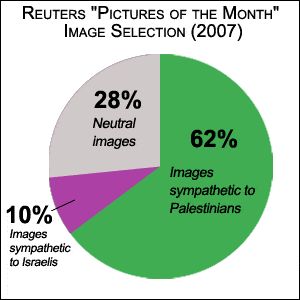 Having previously challenged Reuters for its objectivity in a subjectively selected group of images (see Desk Calendar below), we were interested in seeing if that case represented a one-time aberration, or if Reuters has a serious bias problem in its coverage of the Arab-Israeli conflict.
Having previously challenged Reuters for its objectivity in a subjectively selected group of images (see Desk Calendar below), we were interested in seeing if that case represented a one-time aberration, or if Reuters has a serious bias problem in its coverage of the Arab-Israeli conflict.
We looked at those photographs that featured Palestinians or Israelis included by Reuters in the twelve monthly “Pictures” packages of 2007. We studied 2,666 photos. Our findings are based on 124 photographs of Israelis and Palestinians (promoted by Reuters as the “Best of the Month”):
- 62% of images provoke sympathy for the Palestinians.
- Fifteen photographs of Palestinian funerals were selected as “Pictures of the Month.” None were similarly promoted of Israeli funerals of those killed in the conflict. (Nor were there pictures of funerals from Darfur, Afghanistan, or Sri Lanka from the thousands of combat deaths in those places).
- The images consistently depicted Israelis as the aggressors and Palestinians as the victims. Only 10% of the images could be considered sympathetic to Israelis.
Reuters’ Unfulfilled Commitment to HonestReporting Readers
In January of 2007, HonestReporting encouraged readers to contact Reuters in reaction to its 2007 Desk Calendar. This calendar contained eleven colorful images depicting culture, sport and people from around the world without any political undertones. Yet, one month featured a Palestinian terrorist accompanied by a less than accurate caption implying sympathy for his cause.
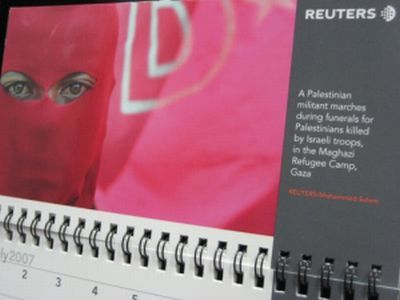 In response to HonestReporting’s readers’ complaints, Reuters Editor-in-Chief David Schlesinger posted an entry on his personal blog:
In response to HonestReporting’s readers’ complaints, Reuters Editor-in-Chief David Schlesinger posted an entry on his personal blog:
Recently, one website – Honest Reporting – suggested its readers send in responses to my posting on photo standards to raise the issue of Reuters 2007 calendar. The calendar became a topic of discussion because one month’s photograph was of a Palestinian militant. That photo stood out as most of the others selected for other months were of dancers, swimmers, performers or farmers…
…The many comments we have received about the selection will certainly be taken into account the next time any company committee puts together a selection of images for a calendar or other purposes.
We assumed that Schlesinger’s promise to “take into account” readers’ complaints would mean that future photo packages would be more balanced.
Pictures of the Month
The “Pictures of the Month” selections meet Schlesinger’s definition of when a “company committee puts together a selection of images for a calendar or for any other purposes.” If his promise to HonestReporting’s readers was true, we would expect to see a balanced and unbiased collection of photographs each month that had been deemed fit to be part of the best Reuters’ images for the month.
We analyzed every month’s selections, a total of 2,666 photographs from 2007. Of these 2,666 pictures, 125 depicted scenes and people from Israel and the disputed territories. We found that 62.4% of the pictures could be classified as either evoking sympathy for the Palestinians or a negative reaction towards Israelis. Only 10.4% could be seen as producing any understanding for the Israeli side.
We found an abundance of pictures of Palestinian funerals of those killed by Israeli military actions, numerous pictures of Israeli soldiers appearing to demonstrate aggression against Palestinian civilians, and a wide selection of photographs depicting Palestinian suffering. By contrast, very few of the images we looked at were sympathetic towards Israelis.
There were no pictures of funerals for Israeli victims of terror and very few pictures of Palestinians as aggressors or Israelis as victims. Taking into account that Israel, during that period, suffered over 2,000 terror attacks, one might even expect the opposite figures to be true. Over time, such a selection is clear evidence of bias and is not in keeping with Schlesinger’s pledge.
All the images published in our report were not only included in the “Pictures of the Month” selections on the Reuters website, but were also published on the Internet by Reuters’ clients. We include them here for analysis and discussion and are covered legally by Fair Use policy. (Click here to view thumbnails on the Reuters website of all the pictures used for this analysis.)
Palestinian Funerals
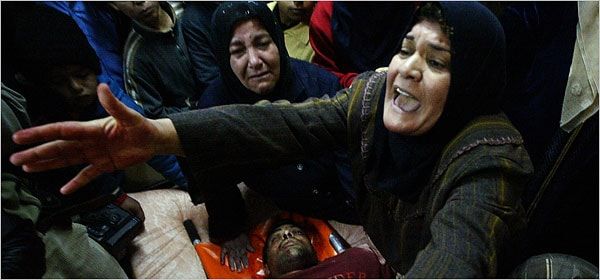
In 2007, conflicts in Darfur, Afghanistan, Sri Lanka and a multitude of other locations produced thousands more casualties in comparison to Palestinians or Israelis. Yet, not one funeral from those conflicts “made it” into any Reuters “Pictures of the Month” packages.
Funerals for those killed during military conflicts are, by definition, emotive. The photo above was taken in Jenin after three members of the Islamic Jihad terrorist group were killed by the Israel Defense Forces. The picture clearly depicts the anguish of the relatives of the deceased. The story told by the picture is one of loss and despair.
Yet, it is questionable why Reuters felt the need to include so many similar pictures of Palestinian funerals as “Pictures of the Month.” Fifteen times, photographs of black-clad women and/or children wailing at funerals were included in the promotional packages.
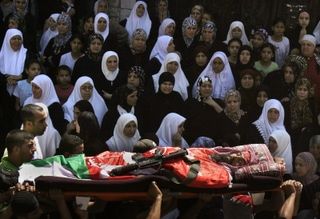 Reuters cannot make the case that the reason for so many highlighted pictures of Palestinian funerals is due to the sheer number of casualties. If this was the standard, why were there no similar images of funerals from the conflicts listed above?
Reuters cannot make the case that the reason for so many highlighted pictures of Palestinian funerals is due to the sheer number of casualties. If this was the standard, why were there no similar images of funerals from the conflicts listed above?
Thirteen Israelis lost their lives as a result of Palestinian attacks last year. Continuing Palestinian terrorism is a major issue in the peace process. Yet, why isn’t suffering of Israelis (or other peoples for that matter) as compelling an image as weeping Palestinians?
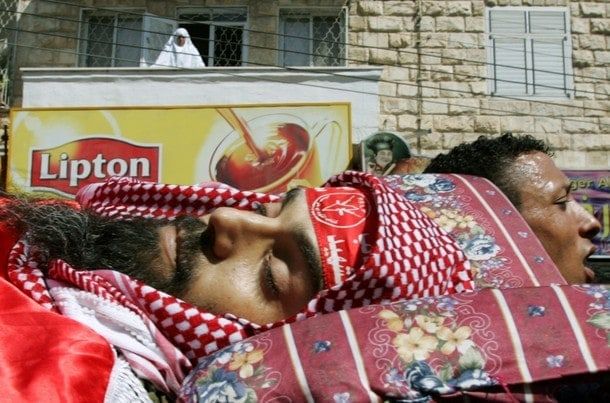 Even more troubling is Reuters’ unwillingness to accurately describe terrorists’ funerals as those of terrorists. Time after time, Reuters captions refer to “militants” or simply “Palestinians” killed by Israeli strikes, even when the deceased were active members of terrorist organizations. Could certain images and captions be used because they soften the image of a terrorist?
Even more troubling is Reuters’ unwillingness to accurately describe terrorists’ funerals as those of terrorists. Time after time, Reuters captions refer to “militants” or simply “Palestinians” killed by Israeli strikes, even when the deceased were active members of terrorist organizations. Could certain images and captions be used because they soften the image of a terrorist?
The two pictures on the right were taken at the same funeral from the same location. In the first one above (Associated Press), the terrorist is being buried with his machine gun. The Reuters shot below shows the same event but we only see the body from the head up. We do not see the gun or the crowds of veiled mourners. Does the Reuters picture create a different impression to that of the AP?
Israeli Soldiers as Hostile
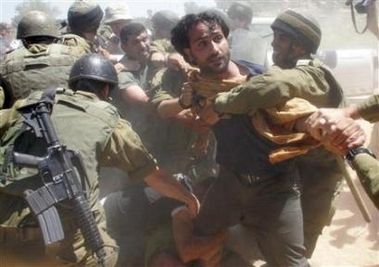 Twenty-seven photos in the ‘Pictures of the Month” series feature Israeli soldiers. Almost all of these show uniformed Israelis in conflict with Palestinians in civilian clothing. This leaves the impression of heavily armed soldiers attacking defenseless civilians.
Twenty-seven photos in the ‘Pictures of the Month” series feature Israeli soldiers. Almost all of these show uniformed Israelis in conflict with Palestinians in civilian clothing. This leaves the impression of heavily armed soldiers attacking defenseless civilians.
The photos included many depicting soldiers breaking up “protests” against Israel’s security fence. The missing context in these images is that the demonstrations often do turn violent. Many of these shots depict regularly scheduled protests in the village of Bil’in that have become known as “photo op” protests.
The same mixture of Palestinian and international “activists” throw stones at the soldiers to provoke a reaction — a reaction that is then captured by photographers such as those of Reuters. Why would Reuters include so many of these “staged” photos in their monthly collections?
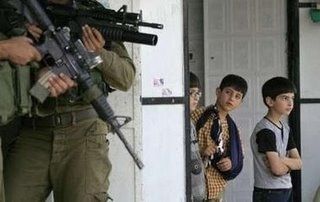 In contrast, only three photographs depicted armed Palestinians. One showed Hamas members in Mahmoud Abbas’s Gaza office, one of a Palestinian police unit raiding a Hamas home, and one of an Islamic Jihad member training for an attack against Israel. For some reason, pictures of armed Palestinians were deemed not as compeling as armed Israelis.
In contrast, only three photographs depicted armed Palestinians. One showed Hamas members in Mahmoud Abbas’s Gaza office, one of a Palestinian police unit raiding a Hamas home, and one of an Islamic Jihad member training for an attack against Israel. For some reason, pictures of armed Palestinians were deemed not as compeling as armed Israelis.
Palestinian Victimhood
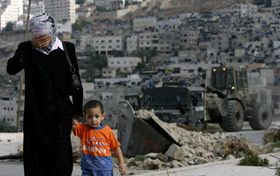 A third category apparent from reviewing the Reuters photos is that of Palestinian victimization. These are among the most moving images in the collections and evoke great sympathy for the Palestinian perspective. We counted nineteen pictures in the “Pictures of the Month” groups fitting this description.
A third category apparent from reviewing the Reuters photos is that of Palestinian victimization. These are among the most moving images in the collections and evoke great sympathy for the Palestinian perspective. We counted nineteen pictures in the “Pictures of the Month” groups fitting this description.
Pictures of wounded Palestinians on stretchers, Palestinian refugees, and Palestinian security prisoners filled out almost every single month’s selections. The captions did not even attempt to put these scenes into context. There is no question of Palestinian suffering in the ongoing conflict. But to imply that the sole cause of this suffering is unprovoked Israeli actions (which is what any viewer would conclude without a more explanatory caption) is false.
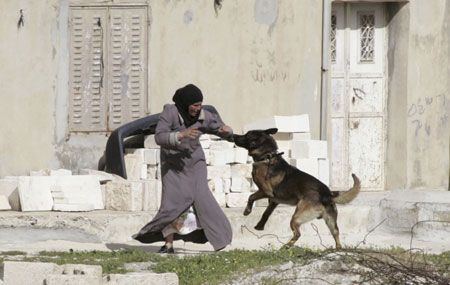 A simple phrase describing prisoners as being “arrested in connection with terrorist activities” would give the viewer vital information about the image. However, such descriptions were normally omitted in favor of more generic descriptions, leaving a question mark as to why the Palestinians in the photographs were arrested in the first place.
A simple phrase describing prisoners as being “arrested in connection with terrorist activities” would give the viewer vital information about the image. However, such descriptions were normally omitted in favor of more generic descriptions, leaving a question mark as to why the Palestinians in the photographs were arrested in the first place.
At the same time, with just one picture of terrified Israeli civilians in Sderot and another of crying Israelis at a Lebanon War memorial, one might wrongly conclude that the suffering in the conflict is entirely one-sided.
Conclusion
Please contact Reuters and ask why the selection of “Pictures of the Month” for every month of 2007 was so unbalanced. Specifically, ask Reuters’ Editors why the selections include:
- Virtually identical pictures of Palestinian funerals and none of those of Israeli victims;
- Armed, aggressive Israeli soldiers facing off against Palestinian civilians and none of Palestinians attacking Israeli civilians; and
- An abundance of pictures of Palestinian victims of the conflict and almost none showing the suffering of Israeli civilians.
Long Term Media Analyses
HonestReporting is committed to monitoring certain media organizations over long periods to determine how objective their reporting is. To read our earlier reports, click on BBC Analysis I, BBC Analysis II, or New York Times Analysis I. If you are interested in sponsoring an upcoming report, please click here.

